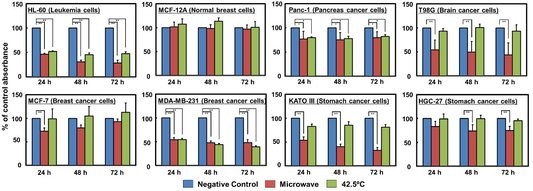Presenter: Mamiko Asano (Mission Research Fellow, RISH Kyoto University)
Title: Effects of normothermic conditioned microwave irradiation on cancer cells — aiming to develop novel cancer therapies
Place: HW525 (Research Building No. 1)
Associated Mission: Mission 5 (Quality of the Future Humanoshpere)
ZOOM Meeting ID: 215-314-2974
Abstract
Cancer is the leading cause of mortality in Japan, and various cancer therapies have been developed to improve patient survival rate. Representative treatments are surgery, chemotherapy, and radiation therapy, and often a combination of these. However, these treatment modalities have several limitations, such as severe side effects and recurrence.
Microwaves, a type of electromagnetic wave, can efficiently generate heat in target substances. Microwaves have been utilized in cancer therapies as a tool for heating cancer cells to a high temperature. Recently, it has become possible to irradiate microwaves to substances with precise control of temperature, output and frequency. In this study, we induced cancer cell death using normothermic conditioned microwave irradiation, wherein the temperature of cancer cells was maintained at 37 °C (Fig. 1). If this could be applied as a cancer therapy, the treatment efficacy would be improved, and heat-related side effects would be avoided.
In this talk, I will first outline the current cancer therapies that involve the use of microwaves. Then, I will introduce our work, which involves the development of a microwave irradiation system and the elucidation of the cell death mechanism induced by this method.
 Figure 1: Viability of cultured cells under microwave irradiation. (Asano M et. al., Sci. Rep., 7, 41244, 2017.)
Figure 1: Viability of cultured cells under microwave irradiation. (Asano M et. al., Sci. Rep., 7, 41244, 2017.)
Microwave irradiation was applied for 1 h with the temperature of the cultured cells maintained at 37 °C, whereas the temperature inside the applicator was set at 10 °C. After the irradiation ceased, cells were moved to a CO2 incubator and incubated for 24, 48, or 72 h. Cellular viability was determined using the WST-8 assay. Rates are shown relative to the absorbance of negative control cells, whose values were defined as “100”. The horizontal axes indicate the duration of incubation after irradiation. Data are expressed as the mean ± SD of four independent experiments. Asterisks indicate significant differences from the negative control: *P < 0.05, **P < 0.01.
PDF file (198 326 bytes) | Top
15 January, 2019


